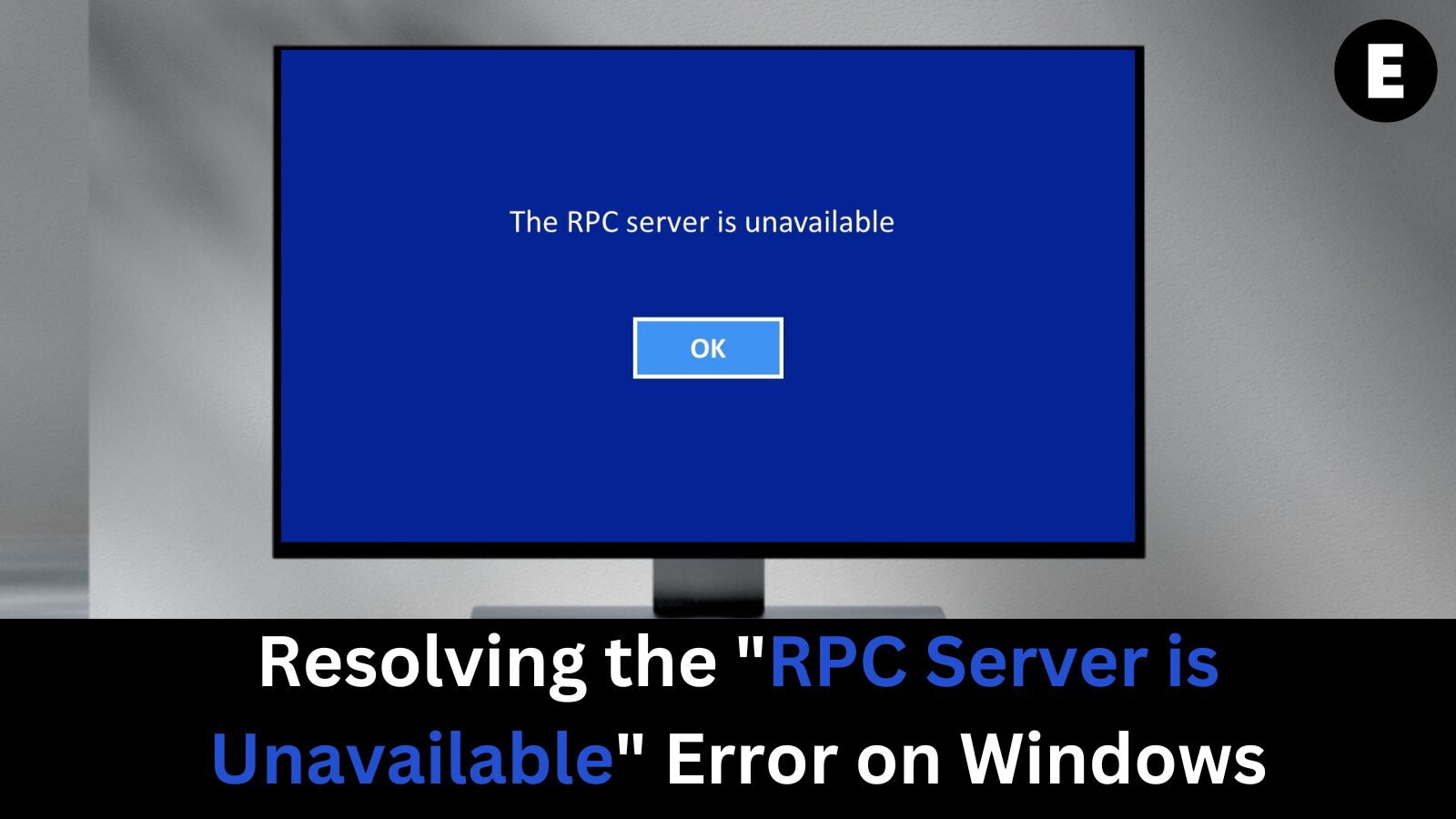Are you encountering the “RPC Server is Unavailable” error on Windows 10 or 11? This common network-related issue can disrupt essential system functions such as file sharing, printer access, and remote data connectivity. If your RPC (Remote Procedure Call) server becomes unresponsive, it may prevent your Windows device from communicating with others on the same network, affecting both home and office workflows. In our comprehensive Windows troubleshooting guide, we break down the most effective solutions to resolve RPC server issues. Whether you’re a tech-savvy user or just getting started, this article will help you restore full network functionality and eliminate frustrating connectivity problems caused by RPC server failures.
What Does the “RPC Server is Unavailable” Error Mean in Windows?
The “RPC Server is Unavailable” error in Windows typically indicates a failure in the Remote Procedure Call (RPC) service—a critical component that enables communication between devices across a network. This service plays a vital role in functions like file sharing, network printer access, and remote device management.
When the RPC server becomes unreachable, it disrupts essential connectivity and can prevent users from managing or accessing other devices on the same network. But what causes this frustrating Windows error?
Here are the most common reasons behind the “RPC Server is Unavailable” error:
- 🔧 Disabled RPC-related services – If key services required by RPC are turned off—either manually, accidentally, or due to malware—your system will lose RPC functionality.
- 🔒 Firewall blocking remote access – An overprotective or misconfigured firewall can block RPC requests, making the server appear unavailable.
- 📁 File and Printer Sharing or IPv6 is disabled – Some RPC services rely on both IPv6 and File and Printer Sharing to function correctly. If either is disabled, RPC errors may occur.
- 🌐 Incorrect IP configuration – A poorly configured IP address or DNS setting might interfere with the RPC server’s ability to connect. Resetting or renewing your IP settings often resolves this.
- 🛠 Registry-level changes – If the RPC service is disabled via the Windows Registry, the system will be unable to use RPC functions until the settings are corrected manually.
Regardless of what’s causing the issue, our step-by-step guide will walk you through reliable methods to fix the “RPC Server is Unavailable” error and restore your Windows system’s network connectivity.
How to Fix the “RPC Server is Unavailable” Error in Windows 10
Experiencing the “RPC Server is Unavailable” error on your Windows 10 PC? This common connectivity issue often arises when essential Windows services related to RPC (Remote Procedure Call) are disabled or misconfigured. Fortunately, you can fix it quickly by ensuring all necessary services are up and running.
✅ Note: These steps are optimized for Windows 10, but they may also work on Windows 11 or earlier versions with minor adjustments.
Method 1: Ensure RPC Services Are Running
One of the most frequent causes of this error is that key RPC-related services have been disabled, often due to third-party software or manual system tweaks. Here’s how to restore and restart them properly:
🔍 Step-by-Step Instructions:
1️⃣ Open Windows Services Manager:
- Click the Search icon on the taskbar or press Windows + S.
- Type “Services” and select the matching result to open the Services app.
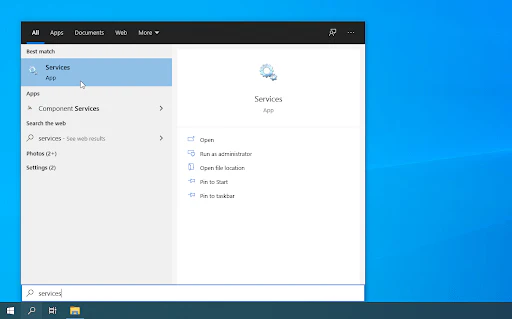
2️⃣ Locate the RPC Service:
- Scroll down to find Remote Procedure Call (RPC).
- Right-click it and choose Properties.
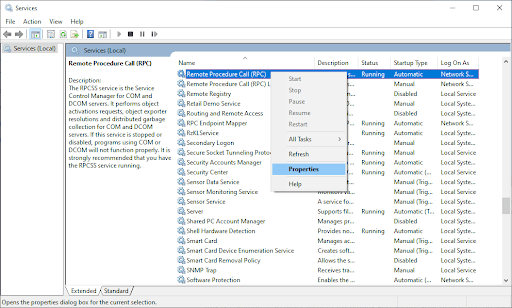
3️⃣ Enable the RPC Service:
- In the Properties window:
- Set Startup type to Automatic.
- Click Start to run the service if it isn’t already active.
- Click Apply, then OK.
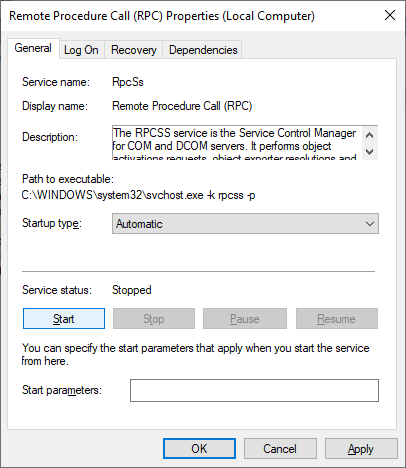
4️⃣ Repeat for the Following Services: Do the same steps (right-click > Properties > Set to Automatic > Start) for these critical services:
- RPC Endpoint Mapper
- Remote Procedure Call (RPC) Locator
- DCOM Server Process Launcher
5️⃣ Restart Your Computer:
- Reboot your PC to apply the changes and refresh system operations.
Method 2: Enable Remote Assistance in Your Firewall Settings
One of the most common reasons behind the “RPC Server is Unavailable” error in Windows is that your firewall is blocking remote connections. While firewalls are essential for system security, they can sometimes mistakenly restrict legitimate services like Remote Procedure Call (RPC).
Instead of turning off your firewall, follow these safe steps to allow Remote Assistance, a feature RPC relies on:
👣 Step-by-Step Instructions:
1️⃣ Open the Firewall Settings:
- Click the Search icon on your taskbar or press Windows + S.
- Type “Allow an app through Windows Firewall” and press Enter.
- Click the matching result to open the correct system settings window.
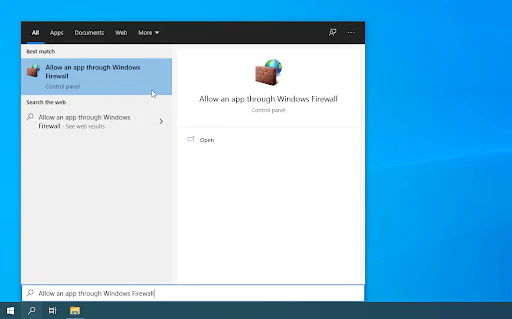
2️⃣ Change Permissions:
- Click the “Change settings” button at the top-right corner.
- ⚠️ Note: This step may require administrator rights. If you’re not an admin contact your IT administrator.
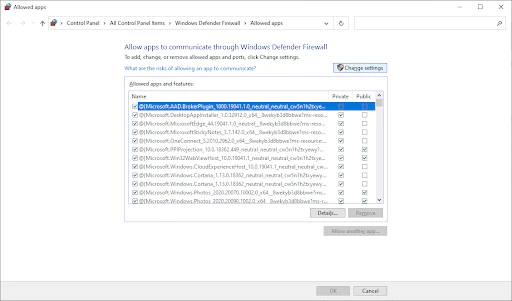
3️⃣ Find Remote Assistance:
- Scroll through the list until you find Remote Assistance.
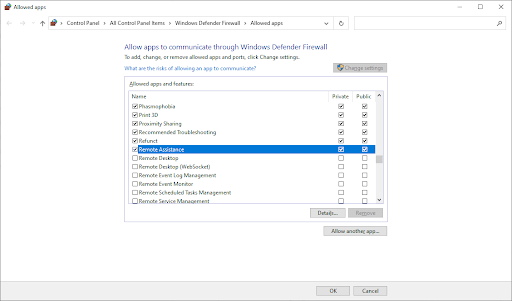
- Ensure all the checkboxes next to Remote Assistance are ticked (both Private and Public).
4️⃣ Apply the Changes:
- Click OK to save your settings.
- 🔄 Restart your computer to ensure the changes take effect.
Method 3: Disable the Selective Startup Feature in Windows
Selective Startup in Windows can prevent essential services like the Remote Procedure Call (RPC) server from launching properly during system boot. If you’re getting the “RPC Server is Unavailable” error, this startup setting might be the culprit.
Disabling Selective Startup ensures all necessary Windows services load correctly. Here’s how you can do it:
🔧 Step-by-Step Instructions:
1️⃣ Open the Run Utility:
- Press Windows + R on your keyboard to open the Run dialog box.
- Type
msconfigand hit Enter. This opens the System Configuration window.
2️⃣ Switch to Normal Startup Mode:
- Make sure you’re on the General tab.
- Select the “Normal startup” option, which loads all device drivers and services.
- Click Apply, then click OK to save your changes.

3️⃣ Restart Your Computer:
- Reboot your system to apply the new startup settings.
- After restarting, check to see if the RPC server error has been resolved.
✅ Tip: Selective Startup is commonly used for troubleshooting, but leaving it enabled permanently may interfere with critical Windows functions like networking and device communication.
Method 4: Flush and Renew Your DNS to Fix RPC Server Errors
If you’re still encountering the “RPC Server is Unavailable” error, outdated or misconfigured DNS settings may be to blame. A corrupt DNS cache can interfere with network communication, which is crucial for RPC services to function properly.
By flushing and renewing your DNS, you can reset your network settings and potentially resolve connection-related issues on Windows.
🧼 Step-by-Step: How to Flush and Renew DNS on Windows
1️⃣ Open the Command Prompt as Administrator:
- Press Windows + R to open the Run dialog box.
- Type
cmdand press Enter. - For best results, right-click on Command Prompt in the search results and select “Run as administrator.”
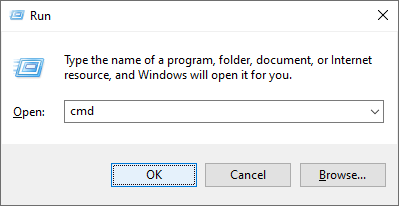
2️⃣ Flush Your DNS Cache:
- In the Command Prompt, type the following command and hit Enter:
ipconfig /flushdns - This clears your current DNS resolver cache.
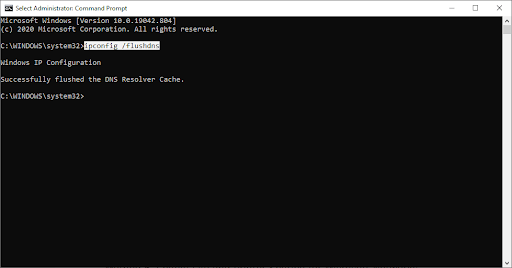
3️⃣ Renew Your IP Configuration:
- Now, run this command to request a new IP address from your DHCP server:
ipconfig /renew - This helps resolve any potential issues related to outdated or conflicting IP settings.
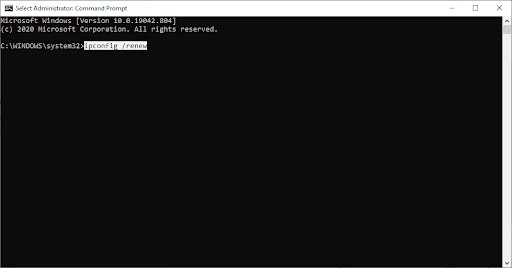
4️⃣ Restart Your System:
- After executing both commands, close the Command Prompt.
- Restart your computer to apply the changes.
✅ Pro Tip: Regularly flushing your DNS can help prevent future network errors and boost overall system performance, especially after changes to your network or DNS settings.
Method 5: Enable File and Printer Sharing for Microsoft Networks
A common cause of the “RPC Server is Unavailable” error in Windows is a misconfigured network. If File and Printer Sharing for Microsoft Networks or IPv6 is disabled, Remote Procedure Call (RPC) services may fail to function properly. Thankfully, enabling these features is a quick and easy fix that restores full RPC functionality.
🛠️ Step-by-Step: Turn On File and Printer Sharing in Windows
1️⃣ Launch the Control Panel:
- Press Windows + R to open the Run dialog.
- Type
controland press Enter to open the Control Panel.
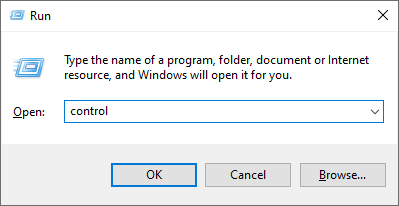
2️⃣ Navigate to Network Settings:
- Click on Network and Internet > Network and Sharing Center.
- If you don’t see this option, change the View by setting in the top-right corner to Category.

3️⃣ Access Adapter Settings:
- From the left-hand menu, click Change adapter settings.
- This opens a list of your active and inactive network connections.
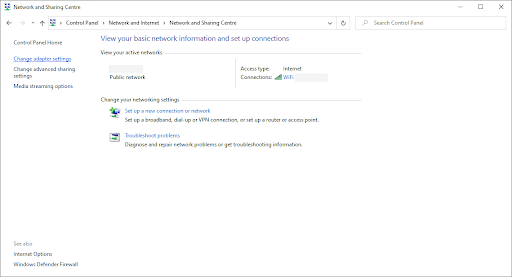
4️⃣ Edit Network Properties:
- Right-click on the active network connection and select Properties.
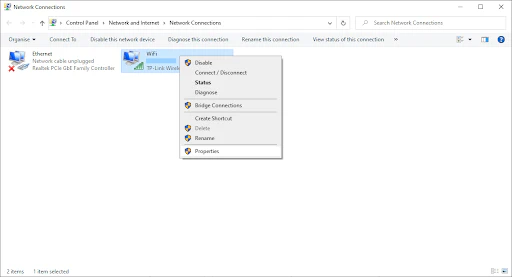
- In the list, locate:
- ✅ File and Printer Sharing for Microsoft Networks
- ✅ Internet Protocol Version 6 (TCP/IPv6)
- Ensure both options are checked to enable them.
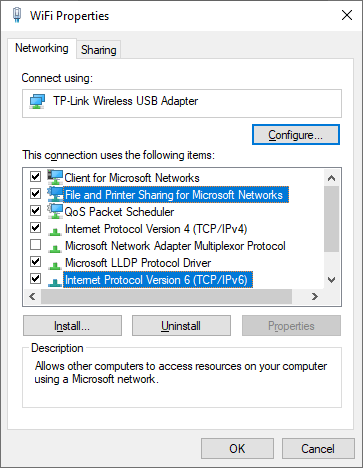
5️⃣ Save and Restart:
- Click OK to apply changes.
- Restart your computer and verify if the RPC server error has been resolved.
🔧 Why this works: RPC relies on proper network communication. Without File and Printer Sharing or IPv6 enabled, devices can’t communicate over the network, resulting in the “RPC Server is Unavailable” error.
Method 6: Force RPC Services to Start via the Windows Registry
If you’ve tried all previous methods and you’re still seeing the “RPC Server is Unavailable” error, you may need to force essential RPC services to start using the Windows Registry Editor. This method is slightly advanced, so proceed with caution — and always create a backup of your registry before making any changes.
🛠️ Step-by-Step: Force Start RPC Services via Registry
1️⃣ Open the Registry Editor:
- Press Windows + R to open the Run dialog.
- Type
regeditand press Enter to launch the Registry Editor.
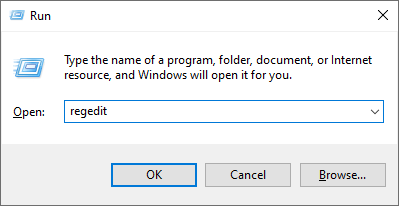
2️⃣ Navigate to the RPC Registry Key:
- Use the left sidebar or paste the following path into the Registry Editor’s address bar:
HKEY_LOCAL_MACHINE\SYSTEM\CurrentControlSet\Services\RpcSs
3️⃣ Modify the ‘Start’ Value:
- In the right pane, right-click on the Start entry and select Modify.
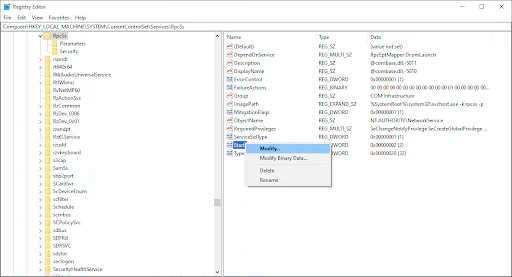
- In the pop-up window:
- Set Value data to 2
- Ensure Base is set to Hexadecimal
- Click OK to save the changes.
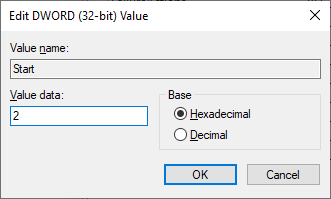
4️⃣ Repeat for Other Required Services:
- Now, navigate to the following keys one by one and repeat the above steps:
HKEY_LOCAL_MACHINE\SYSTEM\CurrentControlSet\Services\DcomLaunchHKEY_LOCAL_MACHINE\SYSTEM\CurrentControlSet\Services\RpcEptMapper
5️⃣ Restart Your System:
- Close the Registry Editor.
- Restart your computer and test whether the RPC server error has been resolved.
Final Thoughts:
The “RPC Server is Unavailable” error is a common but fixable issue that can disrupt network communication, file sharing, and peripheral device usage on Windows systems. Whether you’re running Windows 10, Windows 11, or an earlier version, following the step-by-step methods outlined in this guide can help you resolve the problem quickly and effectively.
From enabling key services and adjusting firewall permissions to making crucial registry tweaks, each method targets a potential root cause of the RPC error. It’s important to go through each fix carefully, starting with the simplest solutions before moving on to advanced ones like registry editing.
✅ Always ensure that:
- RPC-related services are enabled and set to automatic.
- Your firewall and network settings aren’t blocking remote communication.
- You perform regular scans to rule out malware as a cause.
By applying these proven fixes, you can restore your system’s normal functionality and eliminate RPC-related interruptions.
One more thing
If you’re in search of a software company that embodies integrity and upholds honest business practices, your quest ends here at Ecomkeys.com. As a Microsoft Certified Partner, we prioritize the trust and satisfaction of our customers. Our commitment to delivering reliable software products is unwavering, and our dedication to your experience extends far beyond the point of sale. At Ecomkeys.com, we provide a comprehensive 360-degree support system that accompanies you throughout your software journey. Your trust is our foundation, and we’re here to ensure that every interaction with us is a positive and trustworthy one.

